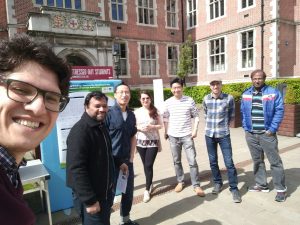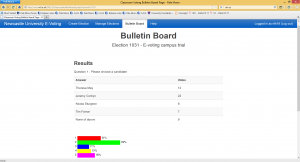Next week in ESORICS 2016, I will be presenting our paper (co-authored with Feng Hao) on a new e-voting system which we call DRE-ip. The system is designed for e-voting in supervised environments, that is, in polling stations, but alternative implementations of the underlying idea can also be used for remote e-voting (sometimes called i-voting for internet voting).
DRE-ip is an end-to-end verifiable e-voting system that guarantees vote secrecy. These properties are similar to those provided by state-of-the-art verifiable systems like VoteBox, STAR-Vote, and vVote designed to be used in elections in the US and Australia. However, crucially DRE-ip achieves these properties without requiring trusted tallying authorities. These are entities holding the decryption keys to encrypted ballots.
In almost all systems with tallying authorities, the votes are encrypted to provide vote secrecy. These encrypted ballots are posted on a publicly accessible bulletin board to enable vote verification. In some systems, the votes are shuffled (using mix-nets) before the tallying authorities decrypt them individually. In some other systems, they are aggregated (using homomorphic encryption) before decryption and the tallying authorities only decrypt the tally. These two techniques are used to protect vote secrecy from tallying authorities. However, there is nothing to prevent tallying authorities to get together and decrypt ballots on the bulletin board, and even worse, there is no way to detect if this happens. So at the end of the day, we are trusting the tallying authorities for vote secrecy.
DRE-ip works based on a simple observation: if a message is encrypted using randomness r, the ciphertext can be decrypted using the secret key or the randomness r. Now, imagine a situation where multiple messages are encrypted and say, we are interested in finding the sum of these messages. One way would be to decrypt the ciphertexts individually and then find the sum. Another way, if we use a homomorphic encryption, would be to aggregate the ciphertexts first and then decrypt the encrypted sum. These two ways are what other systems are doing. But our observation above tells us that there is a third way: whoever is encrypting the messages can keep an aggregation of all randomness used in encryption and release it at some point, which would enable decrypting the sum of the messages. DRE-ip is built on top of this observation.
In DRE-ip the direct-recording electronic (DRE) voting machine that captures the votes and encrypts them, keeps an aggregation of randomness used in the encryptions as well and at the end of the election releases this value to the bulletin board along with announcing the tally. This enables the public to verify the tally. No secret keys are involved in the process of verifying the tallying integrity, and hence no tallying authorities are required. In fact, the system is set up in a way that no one knows the secret key of the encryption scheme. This means that no one is able to decrypt individual ballots. The election tally is the only information that can be verified given the encrypted ballots and this computation is public.
Having the idea is perhaps the easy part, but the main work is to design a system carefully such that it provides full end-to-end verifiability and at the same time one can argue rigorously about it guaranteeing ballot secrecy. In the paper we give proofs of why using encryption is such a way is secure.
DRE-ip achieves levels of security comparable to those of state-of-the-art systems, but crucially with one less group of trusted authorities. To argue the significance of this, it would be sufficient to just quote Ross Anderson‘s definition of a trusted third party:
A Trusted Third Party is a third party that can break your security policy.





